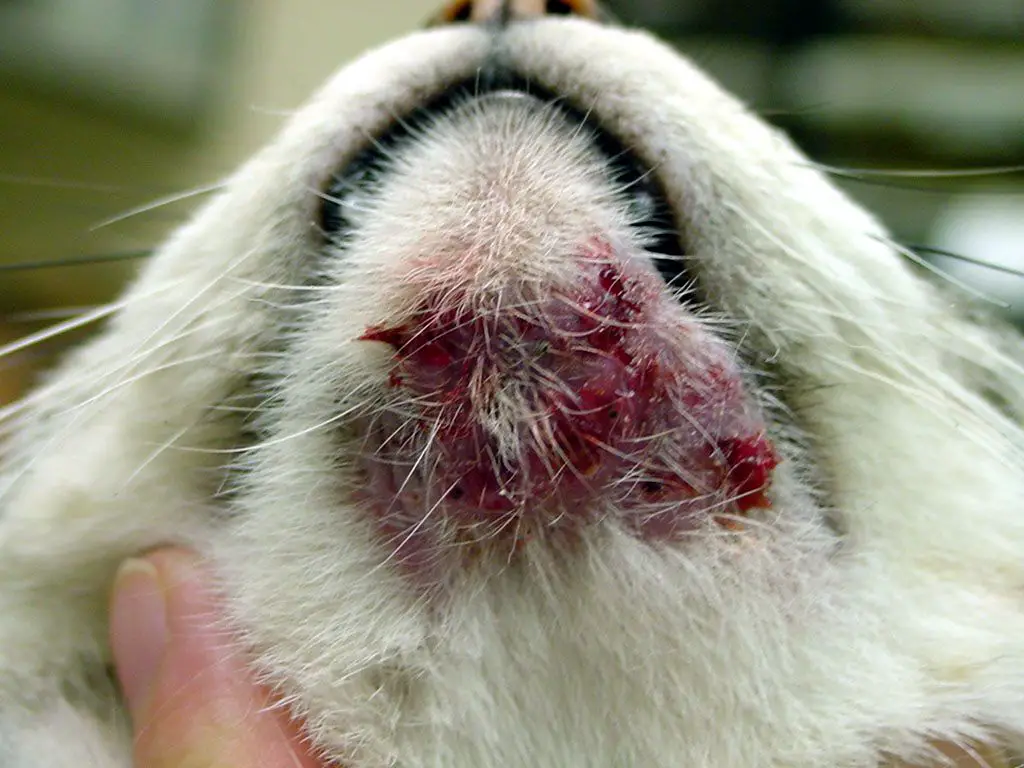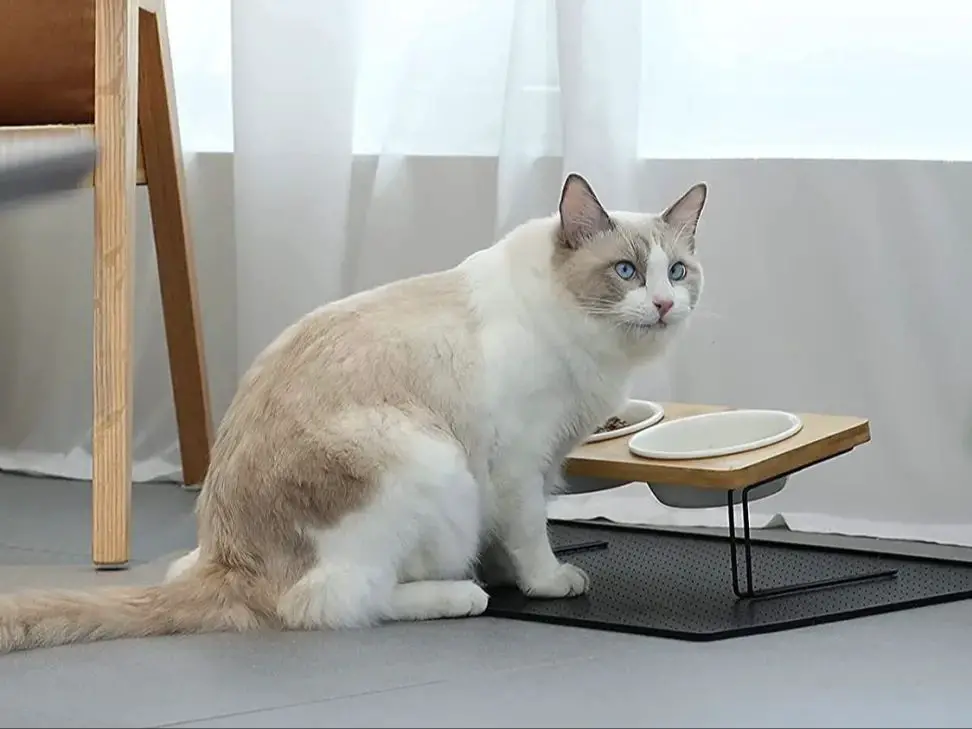What is Feline Acne?
Feline acne, also known as cat acne or chin acne, is a skin condition caused by the overproduction and buildup of keratin and sebum in the sebaceous glands of cats. It most commonly occurs on the chin, lips, and nose where oil glands are the largest.
Feline acne is characterized by blackheads, red bumps, and scaly skin on the lips and chin. The condition results when oil and bacteria clog up hair follicles, much like human acne. Excess sebum oxidizes, hardens, and plugs up the follicle while bacteria multiply, resulting in inflammation and comedones (blackheads).
Symptoms of Feline Acne

Some of the most common symptoms of feline acne include blackheads and pimples appearing on the cat’s chin, lips, and nose. These lesions often present as small red bumps that may contain pus or become crusty scabs. According to PetMD, feline acne can also lead to hair loss around the affected area.
Specifically, the symptoms involved with feline chin acne often include:
- Blackheads and pimples forming on the cat’s chin, lower lip, and nose
- Development of scabs or crusty lesions around the affected areas
- Hair loss around the cat’s chin where acne is present
These symptoms tend to manifest most prominently on the chin, leading to the common name of “chin acne” in cats. However, acne can also spread to the lips and other parts of the face. If you notice any of these symptoms, your cat may have developed feline acne.
Is Feline Acne Painful?
Feline acne can cause varying degrees of irritation, inflammation, and discomfort on a cat’s chin and lips. The severity of pain often depends on the type of lesions present.
Mild comedonal acne characterized by blackheads may only cause minor irritation. However, more inflamed papules and pustules that form scabs and open sores can be quite painful for cats.
According to VCA Animal Hospitals, “The more inflamed the lesions, the more likely they are to be painful.”
Cats may show signs of pain by rubbing or scratching their chin repeatedly. They may also avoid having their chin touched or handled if it is tender and sore from acne.
While mild cases of feline acne may not require treatment, medications can help control pain and inflammation associated with more severe cases. Topical antibiotics, antiseptic shampoos, and corticosteroid creams are commonly prescribed.
Relieving any sources of irritation is also recommended. This may involve changing plastic food bowls to ceramic, washing the chin fold regularly, and grooming to remove scabs and debris.
With appropriate treatment and management, most cats can recover from painful feline acne lesions. However, if the condition persists, a vet should be consulted to rule out underlying causes.
Diagnosing Feline Acne

If you notice signs of acne in your cat, the first step is to take them to the vet for an examination. The vet will look for key indicators of feline acne like blackheads, pimples, and scabs concentrated around the chin, lips, and mouth area.
However, your vet will also want to rule out other skin conditions that could be causing similar symptoms. They may recommend tests like a skin scraping or biopsy to confirm it is acne and not another problem like an allergy, fungal infection, mites, or autoimmune disorder.
According to VCA Animal Hospitals, “Microscopic examination of scrapings from the lesions often reveals Demodex mites, which are normal residents of the skin but are elevated with immune suppression or endocrine disease.”
So a skin scraping can help determine if mites are contributing to acne flare ups. While a biopsy may be done if initial treatments are ineffective at clearing up the acne.
Once your vet can definitively diagnose feline acne as the cause of skin irritation on your cat’s face, then they can recommend the best treatment plan.
Treatment for Feline Acne
There are several treatment options for feline acne depending on the severity of the condition:
Gently cleansing the affected area on your cat’s chin daily can help remove dirt, oil, and bacteria buildup. Using a soft cloth soaked in warm water or an antimicrobial cleanser made for pets can help improve mild cases of acne.
Topical medications prescribed by your vet may also be used to treat feline acne. Benzoyl peroxide gels or creams can help reduce bacteria on the skin and dry out acne lesions. According to VCA Animal Hospitals, topical mupirocin is often prescribed for antimicrobial and anti-inflammatory effects.
Oral antibiotics may be prescribed by your vet if a secondary bacterial infection is present with the acne. Antibiotics help kill bacteria on the skin and reduce inflammation and pus-filled lesions.
In severe cases of feline acne, your vet may recommend using an Elizabethan collar to prevent your cat from scratching and further irritating the affected area while it heals. Scratching can worsen acne and cause scarring.
Home Remedies for Feline Acne
There are some natural home remedies cat owners can try to help treat mild cases of feline acne before resorting to medications or vet visits:
Wiping the cat’s face with a warm, wet cloth can help remove dirt, oil, and debris that clog pores and cause acne. Use a soft cloth dampened with warm water and gently wipe the affected areas 1-2 times per day. Be gentle and do not scrub forcefully (source).
Natural antiseptics like diluted tea tree oil may help kill bacteria on the skin and reduce inflammation. Mix a few drops of tea tree oil with water or unscented gentle cleanser and apply to the affected areas with a cotton pad 1-2 times daily. Tea tree oil must always be heavily diluted before use on pets (source).
Dietary changes to decrease oil production may be helpful. Switch to a grain-free or low-carb, high-protein cat food to reduce glycemic index. Adding omega-3 fatty acids can also help control inflammation and excess oil production.
Preventing Feline Acne

There are some steps cat owners can take to help prevent acne in their cats:
Keep food and water bowls clean. Bacteria and dirt that accumulate in bowls can irritate a cat’s skin and pores. Use stainless steel or ceramic bowls and wash them daily with soap and hot water. Avoid plastic bowls which can harbor bacteria.
Groom your cat regularly, especially around the face. Gently wiping the chin area with a warm, damp cloth can help remove excess oil and dirt. Be careful not to scrub too hard.
Consider switching to stainless steel or ceramic bowls. Plastic bowls more easily harbor bacteria and oils that can contribute to acne. Stainless steel and ceramic are easier to keep clean.
Make sure to clean and disinfect your cat’s bedding frequently. Oils and dirt on bedding can transfer to your cat’s face.
Keep an eye on your cat’s skin and visit the vet if you notice signs of infection or worsening acne. Early treatment can help prevent more severe cases.
When to See a Vet
In most cases, feline acne can be managed at home with gentle cleaning and topical treatments. However, you should take your cat to the vet if the acne persists despite home treatment, there are signs of infection, or your cat seems in distress.
Specifically, make an appointment with your veterinarian if:
- The acne has not improved after 2-3 weeks of home care
- Scabs, open sores, or other signs of infection develop on the chin
- Your cat seems to be in pain or is excessively rubbing or scratching the area
- The acne spreads to other parts of the face or body
- Your cat has difficulty eating or drinking due to the acne
A vet can diagnose the underlying cause, provide prescription treatments, and make sure a secondary infection has not developed. They can also rule out other skin conditions like mites, fungal infections, or allergies. Proper treatment under veterinary supervision can help clear up stubborn cases of feline acne and prevent lasting scarring or pigment changes.
While feline acne is not dangerous on its own, it’s important to monitor your cat’s symptoms and seek veterinary care if home remedies don’t seem to be working. This can help prevent unnecessary pain and complications.

Prognosis for Feline Acne
The prognosis for feline acne is often favorable, especially with proper treatment and management. Many mild cases of feline acne will resolve on their own without any treatment at all. The lesions tend to come and go, so even if acne clears up, it may recur again later in the cat’s life.
According to VCA Hospitals, feline acne “often resolves spontaneously with simple facial hygiene.” With appropriate at-home care such as gentle cleansing and proper nutrition, the acne usually goes away over time. Severe cases or infections may require antibiotic treatment from a veterinarian. As long as the underlying cause is addressed, feline acne is not considered a serious condition.
Though unsightly and sometimes uncomfortable, feline acne is very rarely dangerous or life-threatening on its own. With proper management and care, most cats have an excellent long-term prognosis. Keeping the chin clean and monitoring for secondary infections are key to reducing flare ups and preventing complications. Overall, feline acne is a benign skin condition that can be effectively managed in most cats.
Key Takeaways
Feline acne is a common skin condition in cats, but it is manageable with proper treatment and care. While feline acne can cause irritation, red bumps, and potential scabbing, it is not typically a severely painful condition for cats.
In mild cases, feline acne leads to minor discomfort that does not require medical treatment. However, persistent or severe feline acne can cause more irritation and inflammation that may warrant veterinary attention. With prescription medications, antibiotics, and proper hygiene, feline acne can be controlled.
The key takeaways are that feline acne is common but very treatable. Most cats experience relatively mild irritation and discomfort from feline acne that does not require intense medical intervention. However, pet owners should closely monitor symptoms and seek veterinary care if the feline acne becomes severe or does not clear up on its own.

